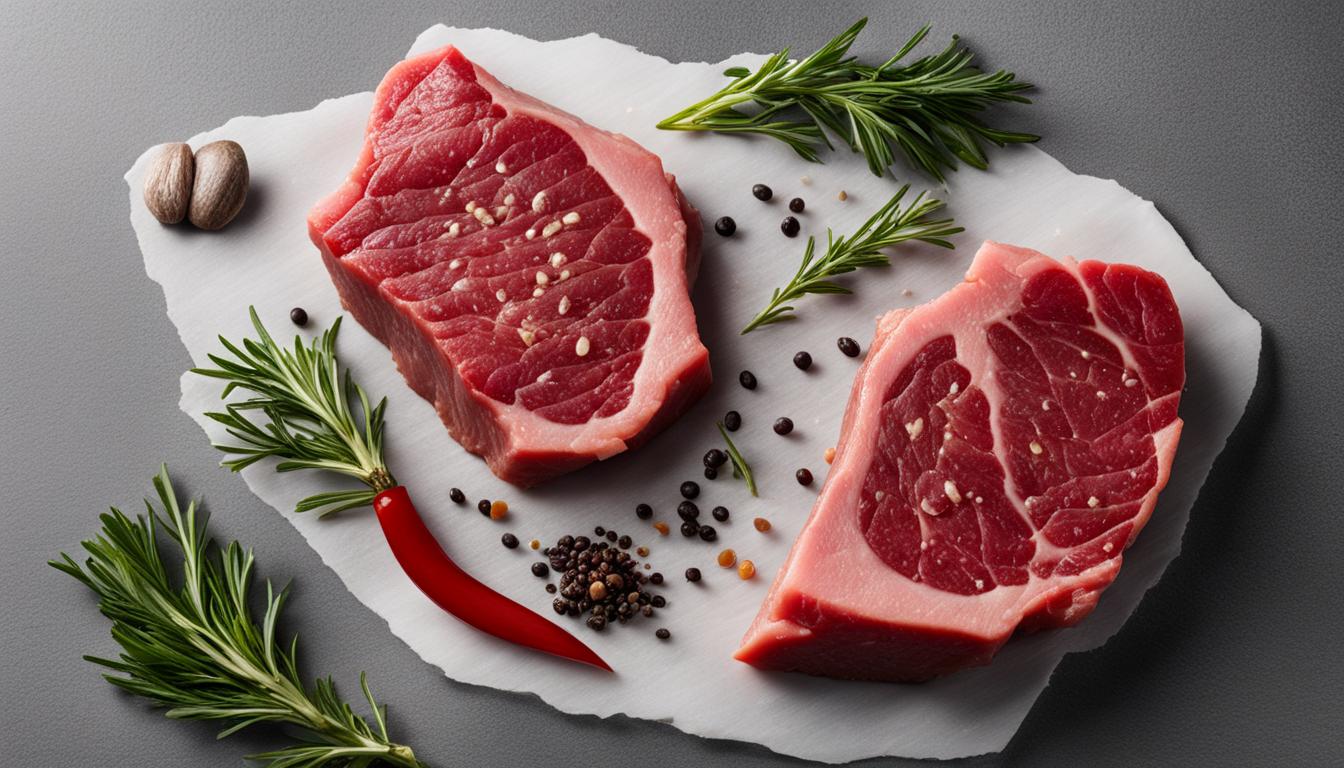As an enthusiast of culinary quality, my journey into the kitchen often begins with selecting the finest cuts of meat. A crucial start to any steak-related ambition, however, is discerning whether the steak in question is of adequate quality to grace the pan.
The conundrum of ‘How To Tell If Steak Is Bad’ stands as an obstacle between a delectable meal and a potential disaster. Thorough scrutiny for signs of spoiled steak is absolutely imperative. I have honed steak freshness tests into an art form, considering steak spoilage the arch-nemesis of culinary mastery. The knowledge of testing steak quality is a must-have arrow in the quiver of any home chef.
Engaging in the fight against spoilt cuts, one should employ all senses to highlight any warning signs. My goal today is to impart the caution and precision needed to spot rogue steaks. Whether you’re a novice griller or an experienced kitchen hand, the hints I lay out here are essential in safeguarding the quality of your meal, and crucially, your health.
Key Takeaways
- Always conduct a thorough examination of steak using sight, smell, and touch to detect spoilage.
- Discoloration, a sour or ammonia-like odor, and a slimy texture are the main signs of spoiled steak.
- The use-by date is a guideline; always verify freshness as steak can spoil before the indicated date due to mishandling or poor storage.
- Proper storage is essential to preserve steak quality; keep raw steak in the fridge for 3 to 5 days maximum.
- When in doubt about steak quality, err on the side of caution and do not consume.
Understanding Steak Sell-By and Use-By Dates
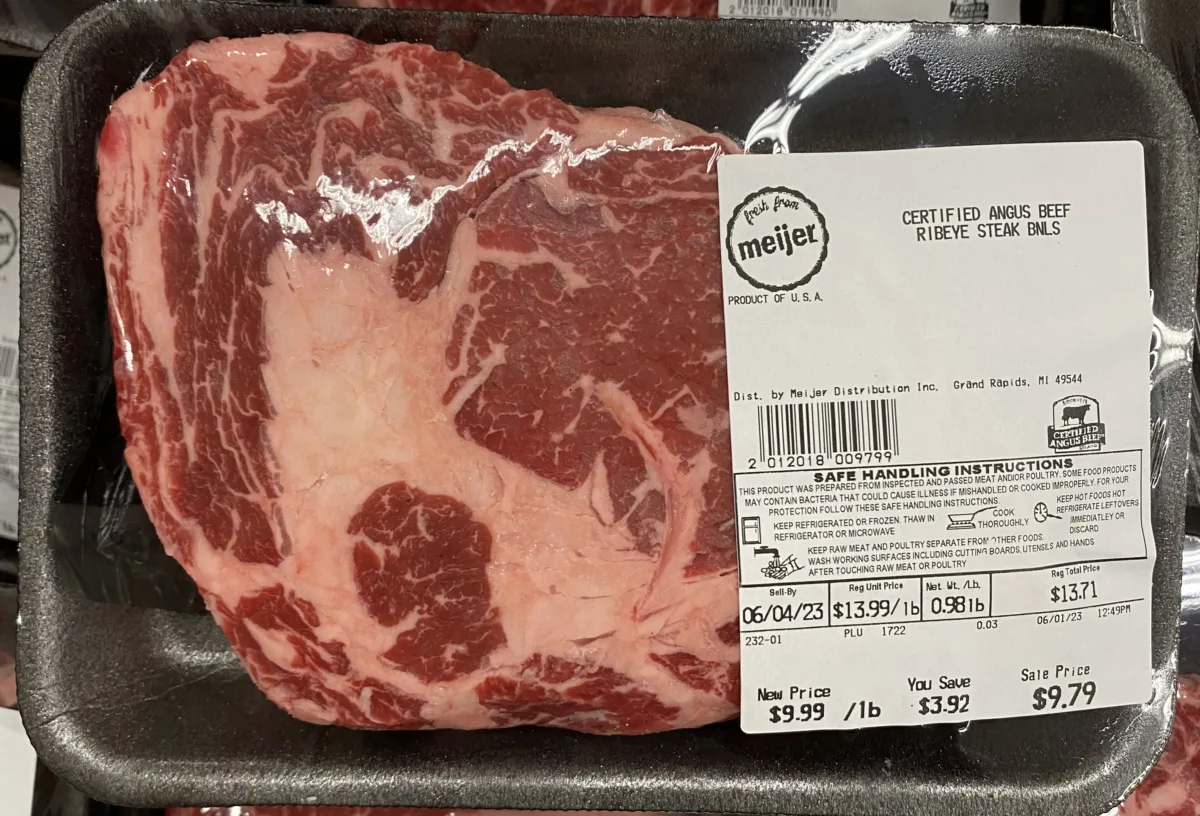
As a conscientious home cook, I find it imperative to comprehend the labyrinth of dates printed on steak packaging. These dates are signposts guiding us toward the enjoyment of steak at its optimal quality and ensuring the safety of our meals. Let’s delve into the nuances of these dates and how they influence our judgment and storage practices for steak.
Defining Sell-By, Use-By, and Best Before Dates
Sell-by dates are indications for retail stores on how long to showcase the steak, aimed at ensuring that you, the consumer, receive the product while it’s fresh. However, contrary to common misconceptions, this date is not the final day the steak can be consumed. Following sell-by dates, I’ve often found that the steak can still maintain freshness for a time, provided it is stored correctly and promptly.
Moving on, use-by dates suggest the last recommended day for consuming the steak while it’s at its peak quality. This assurance of quality does not equate to an expiration or safety date, with the exception of certain products like infant formula. Cast your eye on the packaging and you might witness a best-before date that speaks solely to the flavor and quality aspect–before the steak starts to lose its optimal characteristics, not necessarily when it becomes unsafe.
As my experiences and research dictate, simply abiding by these dates without further investigation could lead to premature disposal of perfectly good steak or, conversely, consumption of subpar meat.
Interpreting Dates for Freshness vs. Safety
How do I differentiate freshness versus safety when interpreting steak dates? Freshness pivots on taste and quality, while safety hinges on healthfulness and the prevention of foodborne illnesses. A steak beyond its best before date might lose some of its savoriness yet can remain safe to eat. However, surpassing the use-by date may usher in a higher risk of bacterial growth, demanding a discerning assessment before proceeding to cook.
How Packaging Dates Affect Steak Storage
The journey of storage starts with scrutinizing the dates. My trial-and-true guide is the USDA’s recommendation: raw steak can gallantly stand in the refrigerator for 3 to 5 days. Beyond that, the trenches of bacteria cultivation deepen. I have mastered the art of steak preservation — promptly placing my steaks in the freezer should the need for extended storage arise, acting well before the expiration dates.
| Date Type | Role | Impact on Storage |
|---|---|---|
| Sell-by | Retailers’ timeline for optimal sale | Can stay fresh beyond if stored properly |
| Use-by | Indicates peak quality consumption period | Important for freshness; indicates potential safety concerns if surpassed |
| Best before | Suggests optimal flavor period | Quality may decline but generally safe if stored correctly |
Interpreting steak dates is a nuanced art form that balances the thin line between freshness versus safety. The effect of packaging dates plays a crucial role in the longevity of the meat, and as such is invaluable for any meat aficionado. My creed in meat preservation is steadfast — freshness must never overshadow the safety of my dining patrons.
Responsible steak storage informed by adept knowledge of the sell-by date, use-by date, and best-before date will undoubtedly elevate one’s culinary experience, ensuring both delectable flavor and utmost safety. This, my dear reader, is an essential facet of kitchen wisdom.
Visual Inspection: Recognizing Signs of Spoiled Steak
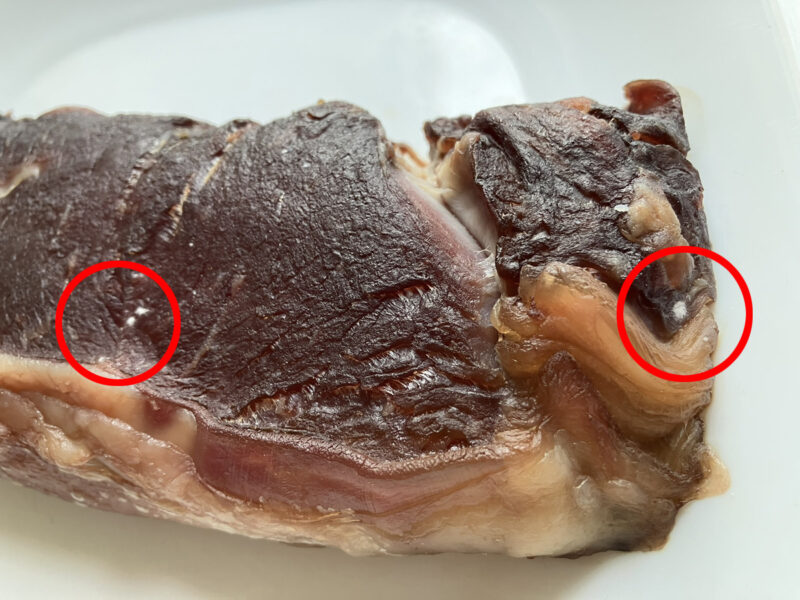
When it comes to the visual inspection of steak, my method is meticulous. I assess each steak with a critical eye, knowing that the difference between a prime cut and a spoiled disappointment can lie in minute details. The first thing I look for is steak discoloration, a tell-tale sign that could indicate spoilage. I understand that harmless oxidation may cause browning, yet certain discoloration patterns can signify deeper issues. Here’s how I decipher the visual cues:
Steak Discoloration: I begin by examining the steak’s color. A fresh, raw steak typically showcases a vibrant, purplish-red hue due to myoglobin, a protein found in muscle tissue. Over time and exposure to oxygen, this can transition into darker brown — a natural process called metmyoglobin formation. However, if I spot patches of color that stray into grey or greenish tones, my alert for recognizing spoiled steak is triggered.
Surface Slime: Next, I check for any slick, slimy film. This layer, unpleasant to both sight and touch, often indicates bacterial growth. It’s the physical manifestation of steak spoilage, and it’s a definitive sign that steak should not pass the threshold of the kitchen into the realm of consumption. In addition to slime, I also watch for any odd or unnatural appearances on the meat:
If the steak’s surface appears wetter or shinier than usual, or if I witness any divergence from the uniform texture I expect from a prime cut, I’m inclined to deem the steak compromised.
Let’s visualize this inspection process with a helpful comparison:
| Feature | Appearance in Fresh Steak | Appearance in Spoiled Steak |
|---|---|---|
| Color | Vibrant purplish-red | Grey, greenish, or abnormally brown spots |
| Texture | Moist with a firm touch | Wet, slick, slimy surface |
| Surface Shine | Minimal shine, due to moisture | Excessive shine, indicating slime |
It’s crucial for any steak connoisseur to understand these visual signs. I stand by my process of meticulous visual inspection, one that guards against the unpleasant repercussions of cooking and consuming a steak gone bad. Armed with this knowledge, you too can ensure that only the highest quality meats grace your dining table.
How the Scent of Steak Can Indicate Freshness
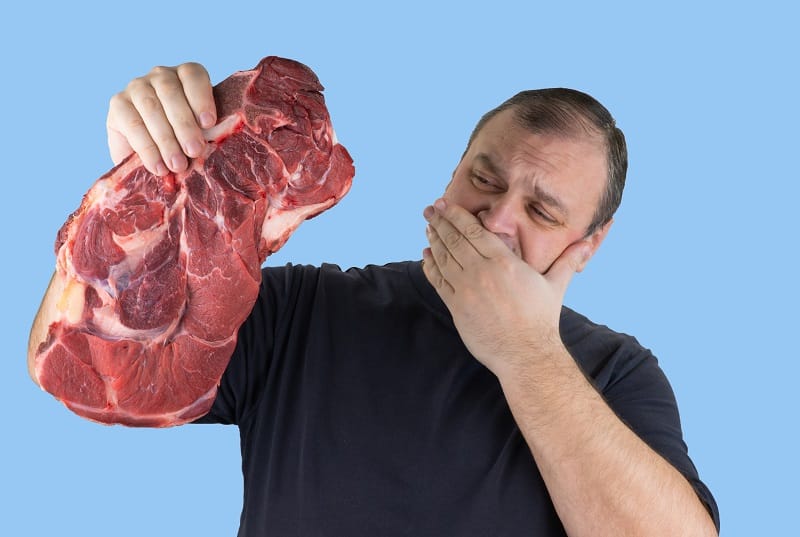
In my culinary endeavors, nothing compares to the satisfaction of cooking a high-quality piece of steak. Yet, the steak scent is an aspect I never overlook, for it holds the truth about the meat’s freshness. A fresh cut exudes a mild, meaty aroma, signaling that the meat is prime for cooking. But when this scent turns foul, the steak’s fate is sealed—it must not reach the grill.
Distinguishing Between Raw and Spoiled Meat Odors
Identifying bad steak odors is crucial in the kitchen. Raw steak should emit a fresh meat odor that is subtle and appetizing. If instead, a steak unveils the spoiled meat smell of tanginess or an off-putting sourness, it’s a clear distress signal that the meat is past its prime. It’s pertinent to trust my senses when these distinguishing odors arise, as they are rarely misleading about the state of the steak.
Identifying Rancid Smells: What to Look For
The rancid steak smell is unmistakable. When a steak begins to spoil, chemical changes often lead to a strong, unpleasant scent reminiscent of ammonia—a stark contrast to the steak’s naturally inviting smell. Although I may encounter a stinky lactic acid smell in dry-aged steaks, which is normal within the controlled aging process, the ammonia smell in steak is a severe red flag for bacterial spoilage, and it should not be confused with the aging process odors.
If the aroma of the steak prompts a grimace rather than eager anticipation for the meal ahead, I take it as a sign to dispose of the steak and prevent any potential health risks.
From the onset of the fragrance to the discerning nose, a spoiled steak declares itself unworthy of consumption.
The table below provides a guide to identifying the state of a steak through its odor, serving as a helpful reference when I’m checking the freshness:
| Odor | Description | Fresh Steak | Spoiled Steak |
|---|---|---|---|
| Mild, Meaty | Subtle and clean, evocative of raw muscle tissue | Yes | No |
| Sour | Tangy and unpleasant, similar to soured milk | No | Yes |
| Ammonia | Strong and pungent, akin to cleaning agents | No | Yes |
| Lactic Acid (Dry-Aged) | A funky cheese-like scent, acceptable within the dry-aging process | Possibly | Consult smell |
It’s my credo to never ignore the tell-tale scents that steak can emit. In the arena of food safety, the role of scent cannot be underestimated. The steak scent has a direct correlation to its freshness, making a sharp nose not just a connoisseur’s attribute, but a guardian of health.
The Texture Test: Feeling for Freshness
Embarking on the steak texture test is a tactile journey, one that I approach with both eagerness and a shade of caution. The sensation transmitted through my fingertips as I execute the touch inspection of steak tells a vivid story about its quality. It’s like a dialogue between the steak and me; a fresh steak communicates its readiness through a moist yet firm texture, whereas a spoiled one sends warning signals of its deteriorated state.
During my routine touch inspections, I’ve refined a set of criteria that a steak must meet to be considered fresh. First and foremost, the steak should present a moist surface without crossing over into the realm of sliminess. Excessive dryness is also a concern, as it can be indicative of a steak left unprotected and exposed, resulting in potential spoilage.
Here’s a simple guide for the feeling of freshness:
- A fresh steak will be slightly wet to the touch but should not leave residue on your fingers.
- A steak past its prime will feel slippery, and your fingers may glide over it with ease – a clear red flag.
- If pressing lightly into the meat leaves an indentation that lingers or oozes liquid, consider this another serious sign of spoilage.
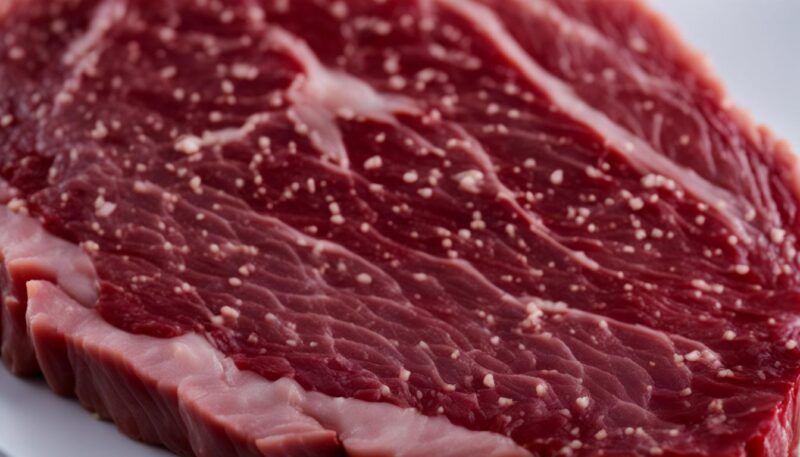
My experiences have taught me that detrimental slipperiness often translates to bacterial presence. If the meat leaves a sticky or tacky residue on my fingers, it is promptly categorized as unsafe meat. This is because a slimy coat harbors microbes, which comprise the steak’s integrity and can pose serious health risks if consumed.
Should a steak fail the texture test by yielding a less than ideal feel, it’s my cue to discard it responsibly and protect myself and others from potential harm.
As a touchstone for determining steak quality, the steak texture test serves as a reliable and immediate inspection tool. Further bolstering my evaluation are visual and olfactory assessments, which, when synchronized with touch inspection results, create a full sensory profile on a steak’s freshness.
Below is a comparative table I use to categorize various textures that I encounter during the touch inspection:
| Texture Quality | Description | Indication |
|---|---|---|
| Moist | Moderate dampness, firm touch | Good freshness and quality |
| Slimy | Sticky, slippery surface | High likelihood of spoilage |
| Dry | Lacks moisture, feels tough | Potential freeze burn or overexposure |
| Residue | Leaves particles on fingers | Possible bacterial growth |
The steak’s texture is a tactile testament to its quality. It whispers secrets that I, as a vigilant home chef, must heed. It tells of the steak’s journey, its handling, and ultimately its suitability for culinary exploits. I rely on this meaty dialogue to ensure each steak that graces the skillet is nothing short of exceptional—safe, savory, and supremely satisfying.
Steak Storage: Tips for Refrigeration and Freezing
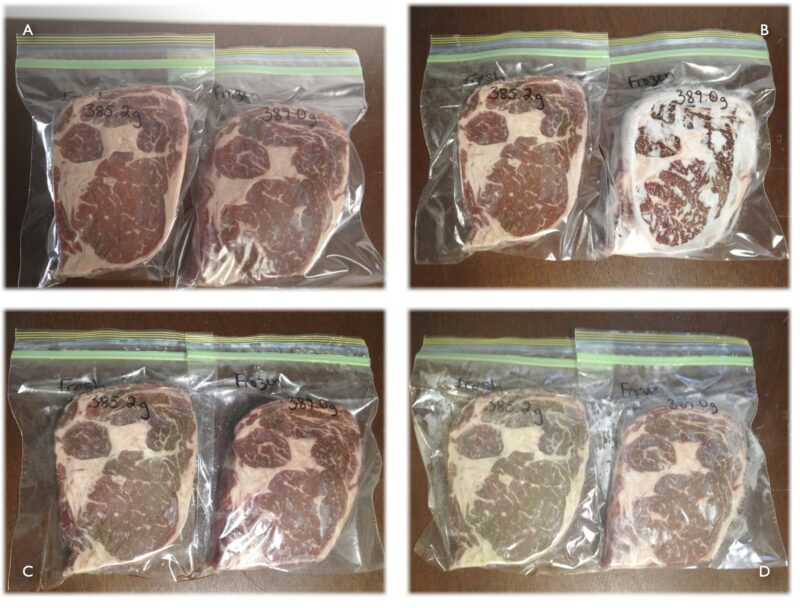
When embarking on the journey of steak refrigeration, understanding the optimal storage timelines is critical for maintaining the utmost quality of your meats. My approach is predicated upon the USDA’s guidance, framing the refrigeration time frame for raw steak storage within a window of 3 to 5 days. Beyond this period, one risks encountering the undesirable effects of bacterial proliferation, jeopardizing both the steak’s taste and safety.
Optimal Refrigeration Time Frame for Raw Steak
Careful scrutiny and adherence to refrigeration guidelines ensure the steak’s freshness prior to its preparation. To practice optimal raw steak storage, I meticulously label each cut with the date it enters my refrigeration unit. Prudence dictates these steaks must be cooked or transitioned to a frozen state well within the prescribed time frame. This vigilance not only safeguards against spoilage but also fortifies the integrity of the culinary experience.
| Refrigeration Time Frame | Action | Expected Outcome |
|---|---|---|
| 0-2 Days | Keep in refrigerator; observe for freshness | Steak remains at peak quality |
| 3-5 Days | Consume or freeze | Mitigate risk of spoilage; retain quality |
| Post-5 Days | Discard if unfrozen | Prevent potential foodborne illness |
Freezing Steak: What You Need to Know
Turning to long-term steak preservation, freezing steak presents itself as a formidable ally. The technique’s beauty lies in arresting the biological clocks of spoilage. Unlocking the secrets to freezing steak effectively, I maintain the temperature at an unyielding 0°F (-17.8°C) to enshrine the steak’s essence indefinitely. I’ve learned that uncooked ground beef and steak thrive best within their prime – 4 months for ground beef, and a window of 4 to 12 months for uncooked steaks and roasts.
Encasing these precious parcels in a tight shroud to avert freezer burn and moisture loss, I employ robust wrapping materials. This barrier is essential in preserving both the texture and flavor, ensuring that the steaks, once thawed, can still summon the sizzle and succulence one rightly anticipates from a premium cut.
Optimal storage isn’t simply a matter of setting temperatures – it’s a ritual that honors the steak’s quality, mandating diligent freezing practices for assured enjoyment down the line.
- Store steak at 0°F (-17.8°C) for ideal freezing conditions.
- Use uncooked steaks within 4 to 12 months for the best quality.
- Wrap steaks meticulously to deter freezer burn and moisture loss.
- Consider vacuum-sealing for enhanced preservation.
In my kitchen, each steak is treated with the respect it deserves, granted the full measure of my meticulousness in refrigeration and freezing methods. Through these practices, I ensure the longevity of flavor and safety, fostering a dining experience that pays homage to the art of meat preparation.
Decoding Color Changes in Steak
Embarking on the path of determining steak freshness, I’ve learned to become adept at interpreting various steak color changes that can reveal much about the meat’s condition. Recognizing whether a color shift in steak is normal or a sign of spoilage is crucial in any culinary endeavor, as the color of steak serves as a primary freshness sign.
Normal vs. Abnormal Color Variations
When I observe a steak transitioning from a bright red to a darker hue, I understand that this is typically due to the normal reaction of myoglobin to oxygen exposure. This chemistry is innocuous, a naturally occurring event in meat packaging called oxidation. Yet, when the steak color changes exhibit abnormal discoloration, such as greenish or yellowish tones, my experience tells me that these are alarming indicators. I know that the steak freshness indicators are signaling an alert.
What Meat Discoloration Tells You About Freshness
Meat discoloration goes beyond mere aesthetic considerations; it speaks volumes about the steak’s viability. Patches that diverge notably from the deep purplish-red color, typically developing browns or yellows, often suggest a compromise in freshness. When such signs of abnormal discoloration are coupled with other concerning factors like a filmy texture or an off-putting odor, I am prompted to discard the steak, for it has likely strayed into the territory of spoilage.
Below is a comparative analysis detailing the variations in steak color I monitor, as not all variations signal the end of freshness:
| Color Change | Normal Variation | Abnormal Discoloration |
|---|---|---|
| Red to Dark Brown | Typical oxidization process; preserves freshness | If accompanied by off smells or slime, indicates spoilage |
| Purplish-Red | Color of fresh, well-preserved steak | Staying same over time indicates good storage |
| Greenish, Yellowish Hues | Not normally observed; likely signs of spoilage | Should be avoided and not consumed |
In my culinary practice, the very essence of safeguarding the dining experience begins with an understanding of these hues and their meanings. It’s not simply meat discoloration; it’s a language that I’ve learned to interpret to assure that when the steak is served, it embodies the pinnacle of freshness and quality.
Indeed, a keen eye for distinguishing normal color variations from signals of abnormal discoloration stands as a sentry to health, quality, and enjoyment at the table.
I’ve come to treasure color as a freshness sign and continue to explore its nuances in the journey of mastering steak selection. It is with this knowledge that I approach every potential cut of steak, ensuring that each meal I prepare is not just an occasion, but a celebration of freshness and flavor.
The Impact of Storage Conditions on Steak Quality
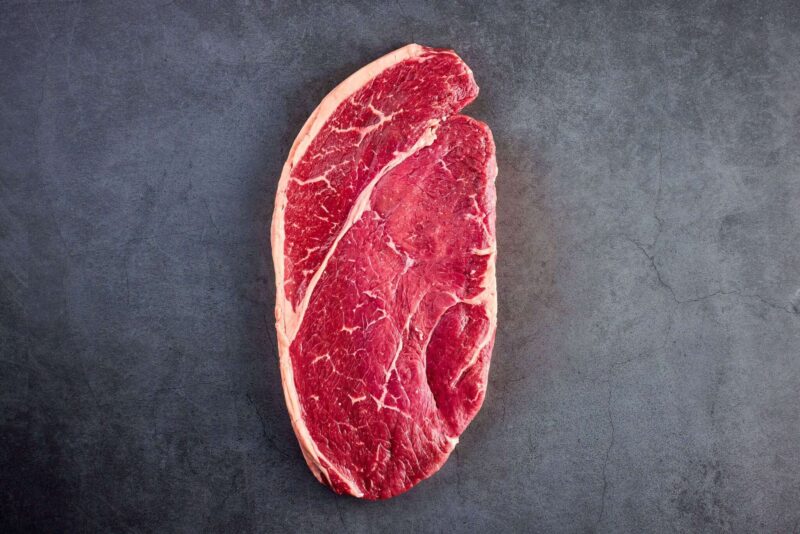
My dedication to meat quality preservation has taught me that steak storage conditions are pivotal in determining the quality and safety of the beef we consume. The impact of storage on steak quality cannot be overstated, as temperature, humidity, and air circulation are elements that can champion the cause of freshness or spell the doom of spoilage.
Temperature is the maestro of meat preservation. Unwavering vigilance in maintaining a fridge temperature between 33°F and 40°F (0.5°C to 4.4°C) is a practice I follow religiously. As for freezing, it is paramount to ensure a constant temperature of 0°F (-17.8°C) – the cold bastion against the siege of bacteria.
Humidity, too, is a key player. Excessive moisture paves the way for bacterial fiestas, while too little can desiccate and toughen meat. Similarly, the effects of oxygen exposure led me to champion vacuum-sealed packaging, a surefire barrier between steak and spoilage. Understanding and controlling these facets cultivates a sanctuary for steak storage, rendering my freezer a vault of freshness.
Ensuring peak freshness is a meticulous dance with temperature and packaging—a waltz I perform with my steaks to maintain their quality and extend their palatable lifespan.
Allow me to provide a tableau of how I implement steak storage tactics to secure meat quality preservation and avert the impact of adverse storage conditions:
| Storage Factor | Recommended Condition | Outcome for Steak Quality |
|---|---|---|
| Temperature (Refrigeration) | 33°F to 40°F | Slows bacterial growth, maintains freshness for 3-5 days |
| Temperature (Freezing) | 0°F or lower | Prevents bacteria, retains quality indefinitely |
| Humidity | Moderate; controlled within refrigerator/freezer | Prevents excess moisture or drying out of meat |
| Air Exposure | Limited; using vacuum-sealed packaging | Shields against contaminants and oxidation |
Adhering to these storage durations is not merely a recommendation; it is a creed I abide by to ensure the integrity of the steak’s quality. It speaks of a commitment that transcends regular storage practices, sowing the seeds for a dining experience replete with safety and savor.
The art of extending steak’s shelf life and ensuring meat quality preservation encompasses more than just cold temperatures. It is a holistic approach that marries correct storage conditions with a profound respect for the delicate nature of steak. This union of knowledge and action is the bedrock upon which I construct my pledges of quality to my patrons, guaranteeing them a seat at the table where steak is not only served with skill but also with unwavering assurance of its excellence.
Cooking Safety: When to Avoid Consuming Steak
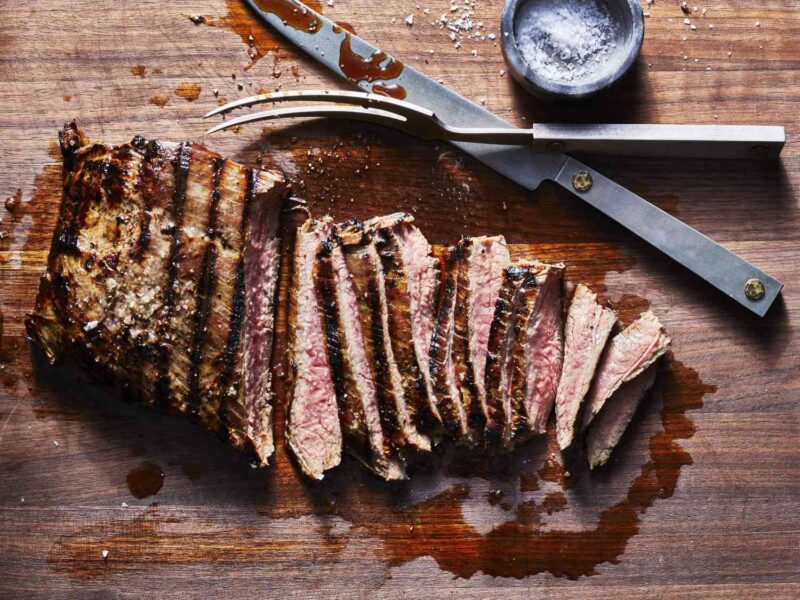
As a culinary enthusiast and advocate for cooking safety, I am compelled to address the pertinent issues around spoiled steak consumption. There are straightforward but critical guidelines one must adhere to when determining the suitability of steak for consumption. In this section, we’ll discuss the risks associated with preparing and eating spoiled steak, and how to recognize when a steak should not be consumed. Knowledge of food safety risks is imperative to prevent the consequences of ingesting spoiled foods.
Food Safety Risks of Cooking Spoiled Steak
The common misconception that cooking can reverse steak spoilage is not only incorrect but dangerous. When a steak is compromised, the threat of food poisoning escalates, presenting a myriad of symptoms that can range from mild to severe. The crux of ensuring safety lies in the preemptive action of identifying and discarding steak that shows unmistakable signs of spoilage through look, smell, texture, or date markers.
The ingestion of spoiled steak, despite having been cooked, poses significant food safety risks. The pathogens that may be present in spoiled meat, such as Salmonella, E. coli, and Listeria, can survive typical cooking processes. These pathogens can lead to foodborne illnesses, marked by distressing symptoms including stomach cramps, diarrhea, vomiting, fever, and in severe cases, hospitalization. It’s vital to recognize and respect these risks as part of essential cooking safety practices.
Ensuring the well-being of those who partake in my culinary creations is paramount; hence, I abide strictly by food safety guidelines to ensure every steak served is free from spoilage and safe for consumption.
Here’s a detailed table showcasing the signs to look for when assessing steak quality, to avoid the consumption of spoiled steak:
| Assessment Criteria | Sign of Freshness | Sign of Spoilage |
|---|---|---|
| Visual Appearance | Uniform purplish-red color | Discoloration, grey/brown patches, slimy film |
| Scent | Mild, fresh meaty aroma | Strong, sour, or ammonia-like odors |
| Texture | Moist but not sticky | Slippery, slimy, or tacky to the touch |
| Date Markers | Within use-by/sell-by dates | Past use-by/sell-by dates |
To further aid in the prevention of cooking and serving spoiled steak, I employ several strategies centered around vigilance and implication of sensory tests:
- Assess the appearance for any discoloration or slime, indicators of bacterial growth.
- Conduct a scent test; any off-putting odors typically illustrate that spoilage has occurred.
- Evaluate the steak’s texture. It should be firm and moist, free from slime or residue that often denotes bacterial presence.
- Verify date markers such as sell-by and use-by dates as an initial check but not as the sole determinant of freshness.
Following these steps is an investment in cooking safety and a proactive approach in avoiding the adverse effects of spoiled steak consumption. It is a duty that extends beyond the kitchen, ensuring the health and satisfaction of those who enjoy the meals prepared.
Remember: When in doubt, throw it out. The pivotal role of these guidelines is to prevent the occurrence of food safety risks. Integrating these measures into my cooking regimen is not only a commitment to culinary quality but a deep-seated respect for the well-being of anyone at the table.
Tips for Buying High-Quality Steak
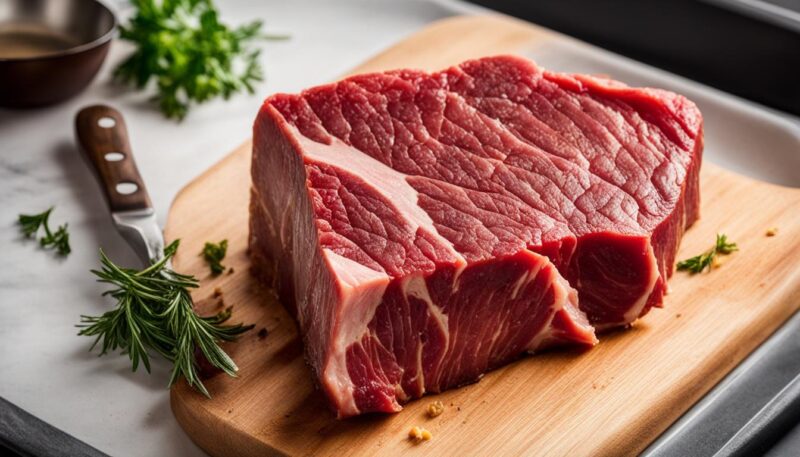
My dedication to culinary excellence begins with the astute selection of high-quality steak. I’ve refined the art of buying steak by prioritizing the quality of flavor and ensuring impeccable freshness. Expertise in selecting steak cuts contributes significantly to the ultimate taste and satisfaction of my steak preparation.
Selecting the Best Cuts for Freshness and Flavor
My pursuit of the finest steak begins with close attention to marbling. Marbling is the interspersed fat that contributes to the steak’s juiciness and flavor after cooking. Cuts like ribeye and New York strip are my go-to options for that delectable balance of fat and meat. For an unparalleled culinary adventure, I turn to genuine Japanese Wagyu beef, renowned for its extraordinary marbling and tenderness.
But appearance is just the starting point. The olfactory engagement comes next. A high-quality steak should not emit any bad odors; it should have a clean, slightly sweet, grassy aroma synonymous with freshness. This approach ensures that the steak procured is as fresh as it is aesthetically pleasing. Furthermore, proper storage and packaging at the point of purchase are vital. A vacuum-sealed steak, stored at the appropriate temperature, is indicative of careful handling and contributes to preserving that vital freshness.
For those who relish a premium dining experience, the diligence applied in selecting steak cuts will manifest as an exceptionally flavorful dish.
Below is a quick reference guide I use when assessing a cut of steak’s quality:
| Cut | Marbling | Optimal for | Flavor Profile |
|---|---|---|---|
| Ribeye | Rich | Grilling | Buttery and robust |
| New York Strip | Moderate | Searing | Meaty and tender |
| Wagyu | Exceptional | Special occasions | Intensely savory and soft |
As a rule of thumb in my buying guide, I ensure the selection process is approached with a discerning eye for steak freshness and flavor quality. A pivotal factor in my selection process is the reputation of the source. Whether it’s a local butcher known for their stringent standards or a purveyor specializing in Wagyu beef, the credibility of the source greatly influences the quality of steak acquired.
- Asses the marbling visually and through touch – it should be visible and felt.
- Examine the color – it should be bright and vibrant, indicative of freshness.
- Smell is a crucial test – no bad odors should be present.
- Packaging matters – it should showcase proper handling and storage.
- Source reputation – ensure you are buying from trusted and well-regarded vendors.
In my continuous journey for culinary excellence, I hold these principles as sacred in selecting steak cuts. By adhering to these standards, buying high-quality steak becomes an intrinsic part of crafting unforgettable meals. It is the harmonious blend of marbling, freshness, and provenance that paves the way to unrivaled gastronomic delights.
FAQ

How can I tell if my steak is bad?
To determine if the steak is bad, conduct three simple tests: inspect the steak for odd discoloration, smell it for sour or ammonia-like odors, and touch it to check for slimy texture. If you observe any of these signs, the steak is likely spoiled and should not be consumed.
What do sell-by, use-by, and best-before dates on steak packages mean?
Sell-by dates inform retailers when the steak should be sold to guarantee quality. Use-by dates suggest when the steak will likely be at its peak quality and flavor—not a strict safety guideline, except for infant formula. Best-before dates indicate when steak is expected to have optimal taste, but consuming steak past this date may result in a decline in flavor, though not necessarily safety.
Can steak be safe to eat after the use-by date?
A steak can be safe to consume after the use-by date if it has been stored properly and shows no signs of spoilage. However, it is crucial to use your senses and judgment to inspect the steak for freshness before deciding to cook or eat it.
How does packaging impact the storage and freshness of steak?
Packaging dates play a significant role in establishing how long steak can be stored. Properly sealed and labeled steak can remain fresh in the fridge for 3 to 5 days. Moreover, proper packaging techniques, such as vacuum sealing, can extend freshness during refrigeration or freezing for longer-term storage.
Are there visible signs that indicate a steak has spoiled?
Yes, visual signs of spoiled steak include abnormal discoloration, such as graying or browning, greenish or yellowish hues, and the formation of slime on its surface, which indicates bacterial growth.
How can the scent of steak help determine its freshness?
A fresh steak typically has a mild, meaty scent. Spoiled steak emits distinct sour smells or ammonia-like odors, which are clear indications of spoilage. The presence of a rancid odor is a strong sign that the steak should not be consumed.
What should I feel for when conducting a texture test for steak freshness?
When performing a texture test, the fresh steak should feel moist but not slimy or sticky. Any sliminess can indicate spoilage due to bacterial growth. If the steak leaves a slippery residue on your fingers, it should be considered unsafe and discarded.
How long can I keep steak in the refrigerator before it goes bad?
According to the USDA, you can refrigerate raw steak for 3 to 5 days to maintain safety and avoid the risk of foodborne illness due to bacterial growth. It is essential to label the steak with the storage date and either consume or freeze it within this timeframe for optimal freshness.
What is the best way to freeze steak for long-term storage?
For long-term storage, freeze steak at 0°F (-17.8°C). Ground beef and steaks should be used within 4 months for ground beef and 4 to 12 months for uncooked steaks. Make sure the steak is well-wrapped to prevent freezer burn and moisture loss for maximum quality.
How can color changes indicate if a steak is fresh or spoiled?
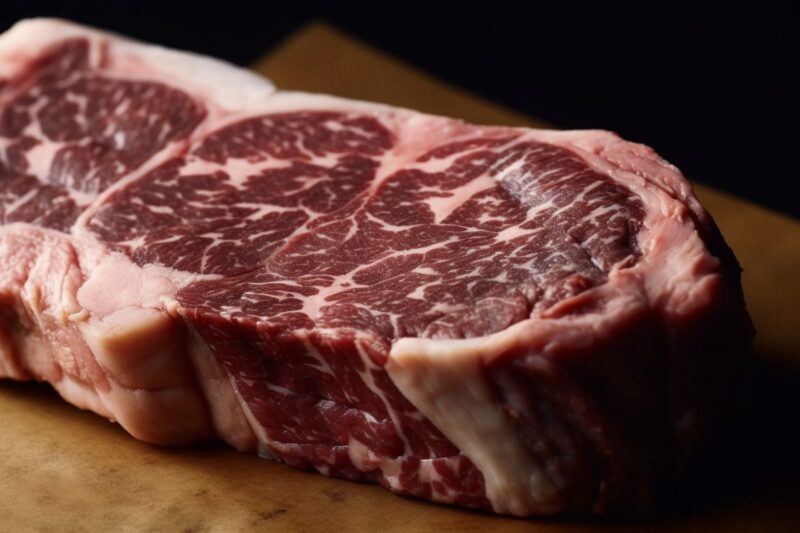
Color changes in steak due to oxygen exposure, like a bright red turning to a darker brown, are normal. However, if you notice greenish or yellowish discolorations or any unusual patches, especially in conjunction with other spoilage signs like sliminess or bad odor, the steak may be spoiled.
How do storage conditions impact steak quality?
Steak quality is influenced by storage conditions including temperature, humidity, and air exposure. To maintain steak quality and prevent spoilage, it’s essential to store steak in the fridge or freezer at the correct temperatures, use vacuum-sealed packaging when possible, and abide by recommended storage times.
Is it ever safe to cook and eat a steak that has gone bad?
No, cooking does not reverse spoilage. It is unsafe to consume any steak that displays signs of spoilage such as an off smell, discoloration, or slimy texture. Doing so can lead to food poisoning, with symptoms ranging from gastrointestinal discomfort to serious illness.
What should I look for when buying high-quality steak?
When buying high-quality steak, seek cuts with good marbling and choose meat from reputable sources. Ensure the steak has no bad odors, is stored or packaged properly, and the meat displays a fresh appearance. Considering the source and cut can enhance both the freshness and the flavor of the steak.
Conclusion: Ensuring Culinary Delight with Fresh, Quality Steak
In the journey of fine cooking and dining, evaluating steak freshness is akin to an art form, a clear dance with science. Throughout my culinary experiences, I have learned that preventing steak spoilage starts with understanding steak dates and ensuring correct storage methods. These foundational principles guide one in maintaining steak quality and providing a remarkable dining experience. From the visual cues of discoloration to olfactory signals of an unsettling scent, every sense plays a pivotal role in ensuring the steak on your plate is as it should be—exquisite and safe.
My culinary ethos has always revolved around a profound respect for ingredients, and steak is no exception. By rigorously adhering to the guidelines of choosing, storing, and evaluating steak, the peril of encountering spoiled meat can be deftly avoided. This commitment to quality not only safeguards against health risks but also heightens the pleasure that a perfectly prepared steak provides. Each slice, sizzle, and savory bite becomes a testament to the meticulous care taken from the butcher’s block to the table.
It is this comprehensive approach—whether through understanding the subtleties of sell-by dates or mastering the nuance of meat storage—that culminates in the assurance of quality. As a culinary connoisseur, I advocate these practices, ensuring that both my kitchen and yours are sanctuaries for fresh flavors and safe, satisfying experiences. Through these guidelines, steak lovers can steer clear of the pitfalls of spoilage and savor the unmatched taste of high-quality beef.

